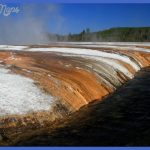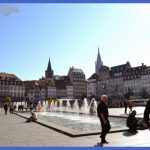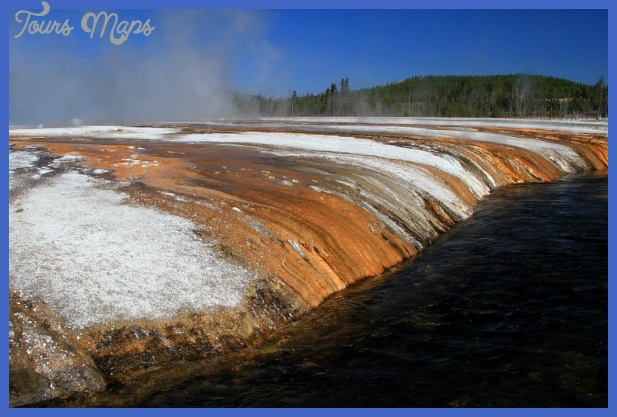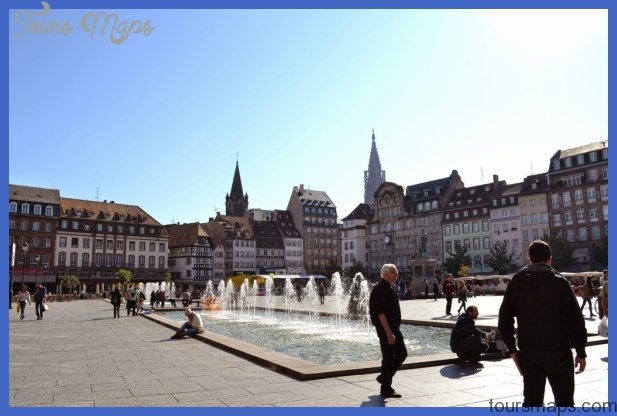Just what Back Basin is back of is not obvious to present-day visitors, but the basin was in back of the museum before the Grand Loop Road was rerouted. NOTE: © The western side of the Back Basin walkway may be accessible with assistance as far as the southern corner of the basin. As you walk through Back Basin, you may wonder what has caused so many trees to fall and lie about helter-skelter, since they were not burned in the 1988 fires. Lodgepole pines have a very shallow root system, and when they The Grand Loop Road cut between the Norris Museum and Porcelain Basin, as shown in this H.C. Bumpus sketch from 1935 grow very tall, as these have done, a strong wind can topple them easily. These trees are mostly about the same age and height; thus, winds have created a sort of domino effect among them. Park policy is to leave them lying unless they actually obstruct a path or road. Turning south (left from the entrance walkway) near the museum, you first encounter Emerald Spring [GEO.23]. Emerald may bubble due to rising gases, even when its water is below the boiling point. At times it gets hot enough to actually boil, and then it becomes a muddy brown color and may erupt as high as 26 feet (8 m). Two eruptions occurred in 2002, three in 2003, and one in 2005.
One phenomenon scientists have researched is a seasonal disturbance that often occurs sometime between mid July and early autumn, particularly in Back Basin. For a week or two, many features at Norris go berserk: Emerald Spring becomes cloudy, Echinus Geyser turns unpredictable (even when routinely predictable), and Green Dragon Spring and Gray Lakes turn chocolate brown and boil furiously. During the disturbances, geologists have noted an increase in the amount of water and gas discharged, increase in the turbidity of the water, large fluctuations in water temperatures, and decreased chloride and increased acidity in some springs. Occasionally, a small hydrothermal explosion creates a new thermal feature. Some geochemists now consider it likely that the Norris seasonal disturbance stems from the mixing of groundwater from two or more different underground zones having different chemical compositions. Leaving Echinus, the boardwalk crosses the South Fork of Tantalus Creek for the first time and passes near several features that have erupted as geysers for short periods in the recent past. Crater Spring and Arch Steam Vent are to the right (north) and left (south) of the path, respectively. Tantalus Geyser (formerly Decker Geyser) is out in the sinter to the north. In the case of Tantalus Geyser, the human history is more interesting than the thermal history. In the 1960s, Mrs. Hazel Decker was so determined to see Steamboat Geyser erupt that she spent 52 consecutive days in the area, sleeping in her car in the parking lot.
Mrs. Decker was rewarded with about 10 eruptions of Steamboat, but a nearby geyser that had been named for her was renamed Tantalus Geyser. A small grove of trees out in the sinter is informally called Decker Island. Tantalus Creek, the small creek that drains both Back Basin and Porcelain Basin, is named for a king in Greek mythology. He was doubly condemned: to stand up to his chin in water that retreated whenever he stooped to drink and to reach up for bunches of grapes that always evaded his grasp. (This myth is the source of our word tantalize.) The creek’s water level and temperature rise and fall with basin-wide geyser eruptions. A long stretch ofthe Back Basin walkway passes springs of different colors, shapes, sizes, and levels of activity. Just before you reach Black Hermit’s Caldron (away from the trail’s corner), you pass another example of a geyser whose name is better than its action, Puff ‘n Stuff Geyser. The late Park Geologist Rick Hutchinson named it after a TV show of the early 1970s called H. R. Puf-nstuf. The geyser gurgles below ground and sprays out some water but has never done much else. Next is cavernous Green Dragon Spring, named for its usual color and its characteristic action, boiling vigorously and belching steam from three funnel-shaped vents. When the steam clears away, you can see greenish yellow crusts of sulfur and red deposits of iron on the cavern roof. Stretching away from this point are two very large hot springs called the Gray Lakes, whose waters are said to be in constant motion, caused by boiling springs on the bottom. West of the Gray Lakes, not visible from the walkway but partially visible from the highway, are the Hydrophane Springs, whose color is reflected in its name and its steam. Hydrophane is a type of opal that becomes translucent when immersed in water.
Phillips Caldron mud pot honors Charles Phillips, a park ranger who was fascinated by geysers. While stationed for the winter at Old Faithful in 1927, he mistook poisonous water hemlock growing in warm thermal runoff for edible wild parsnip and died within a few hours of eating it. West of the path, the Muddy Sneaker Complex (including one small geyser) got its name from geologist Rick Hutchinson in 1971. It was originally a violent mud pot that sprang up suddenly in the trail. Anybody who would walk in it or below it would get their shoes or sneakers muddy, according to Hutchinson. The path has since been moved uphill. boardwalk corner deserves its name only part of the time. Sometimes you can’t see the yellow-stained funnel for the opaque green, blue, or muddy water; sometimes it’s merely a steam vent. Son of Green Dragon north of Yellow Funnel sometimes acts as a geyser. This area of Back Basin, from Yellow Funnel Spring to Pearl Geyser, became so hot in July 2003, with soil temperatures near boiling and new fumaroles everywhere, that park ocials closed the former straight boardwalk. In 2004 a new raised boardwalk loop was built to bypass the hottest area. On this loop you pass the small frequent spouter called Orbicular Geyser (Orby), numerous other spouting vents, and Porkchop Geyser. In the 1980s, Porkchop Geyser was a porkchop-shaped perpetual spouter that formed a tall ice cone from its spray in the winter. Suddenly, on September 5, 1989, Porkchop exploded. A few lucky people were watching as chunks of gey-serite were upended and debris thrown about in a true hydrothermal explosion.
What remains is a steaming pool surrounded by jagged boulders. Although very close to the side of Porkchop, North or Second Eruptor, with small eruptions from its deep vent, has a different temperature and water chemistry from Porkchop. At the boardwalk corner is Pearl Geyser. Its almost translucent pearl-like deposits are now sometimes covered with mud. Pearl Geyser erupts up to 8 feet (2.4 m) high but is unpredictable. Bastille Geyser south of Pearl was born in 1992 on France’s Bastille Day, July 14. It grew from a 2-inch (5 cm) hole to a 3-foot (1 m) crater in 8 hours during a seasonal disturbance. It erupted up to 3 feet (1 m) high every 4 or 5 minutes when active, but it has stopped erupting and has filled in its vents with sinter. The next feature is Vixen Geyser, which may erupt from its red-stained crater for a few seconds every few minutes, except for its rare major eruptions up to 35 feet (11 m). Its much more usual eruptions spout no more than 10 feet (3 m) high. Almost all Vixen’s water drains back into its rectangular vent. This geyser was named by a woman tourist who was splattered by an eruption in 1881 and exclaimed, You vixen, you, according to tour guide George L. Henderson. In 1883, geologist Walter Weed wrote that according to Superintendent Norris, a geyserite cone displayed at the Centennial Exposition in Philadelphia in 1876 came from Vixen. That cone has apparently been lost. On display now at the Smithsonian’s National Museum of Natural History in Geyserite cone donated by Supt. Norris to the Smithsonian (Foley, 2006) Washington is a geyserite cone from Yellowstone, but it could not be the same one. It is labeled as collected in 1881 by Norris himself.
The provenance of this latter cone is an unsolved mystery After crossing Tantalus Creek, you East toward Echinus Near the trail junction on the left are small Corporal Geyser and tiny Dog Leg Spring with two small vents. When one of these geysers erupts the other drains. On the right is Veteran Geyser, which probably derived its name from the very old sinter deposits all around. Veteran’s short eruptions may go out 40 feet (12 m) at an angle, but they occur in a long-term cyclic pattern of minutes to hours that is not yet fully deciphered. The last feature before you reach the North toward the museum If you turn back from Cistern and take up the loop trail again, or if you have continued straight on at the trail junction after crossing Tantalus Creek, you’ll first encounter Palpitator Spring. Pal-pitator is actually a geyser and has small but extremely long eruptions of around 3 hours. Over a hundred years ago, it was named when steam pulsing below the ground produced uncannily rhythmic beats. You will see perpetual spouting at the center of Fearless Geyser at your left (west) as the trail approaches Monarch Geyser on the right. Behind Monarch’s crater is a devastated-looking hillside, showing that Monarch was a truly regal feature at one time, though it has not had a large eruption since 1913. Before that year it could rocket to a height of must choose between going right (east toward Echinus via Cistern Spring) or straight ahead (north toward the museum via the shortest path and past a few more features). stairs up to Steamboat Geyser is Cistern Spring. The remarkable colors in the runoff are unusual for Norris Basin unless you are here during a seasonal disturbance when you may see only murky water.
Cistern built its impressive terrace in the past 30 years. Bacteria color the terraces canary yellow, orange, and brown when the pool is full. True to its name as a water reservoir, Cistern’s water drains drastically when neighboring Steamboat Geyser has a major eruption; without the water, the bacteria die. 200 feet (60 m), spewing out rocks and mud with rumblings that shake the valley (as an 1884 guidebook states). It then became so quiet that it’s sometimes called Monarch Geyser Crater. However, proving that geysers can never be pronounced dead, it began having superheated boiling periods in 1993, with an occasional burst 20 feet (6 m) high. Some researchers believe there may be an underground connection between Monarch and Steamboat geysers. Partway up the small hill north of Monarch Geyser are Mushroom Geyser (named for its mushroom-shaped pedestal deposits, now gone) and Minute Geyser. Minute Geyser erupted at 1-minute intervals as much as 40 feet (12 m) high until about 1902. Unfortunately located near the stagecoach loading dock, Minute Geyser’s vent was blocked by a large boulder thrown in by vandals. This changed the action to another vent that spouts frequently. Minute Geyser has had occasional major eruptions in recent years.
As you continue through the woods, you might notice steam rising to the left (west). Forgotten Fumarole has sometimes acted as a geyser since 2004, erupting to 20-30 feet (6-9 m); Rediscovered Geyser, on a short path of its own, is usually a tiny perpetual spouter. Bathtub Spring is on its own stretch of path between the main walkway and the museum. The spring usually looks just like an old-fashioned tub filled with yellow to light brown muddy water, sometimes spouting continuously. The massive buildup of geyserite is unusual for Norris features and was probably formed during alkaline water cycles within the hot spring, since not much sinter accumulates during acidic cycles.
WALKING TOUR OF BACK BASIN Photo Gallery
Maybe You Like Them Too
- The Best Cities To Visit in The World
- World’s 10 Best Places To Visit
- Coolest Countries in the World to Visit
- Travel to Santorini, Greece
- Map of Barbados – Holiday in Barbados










